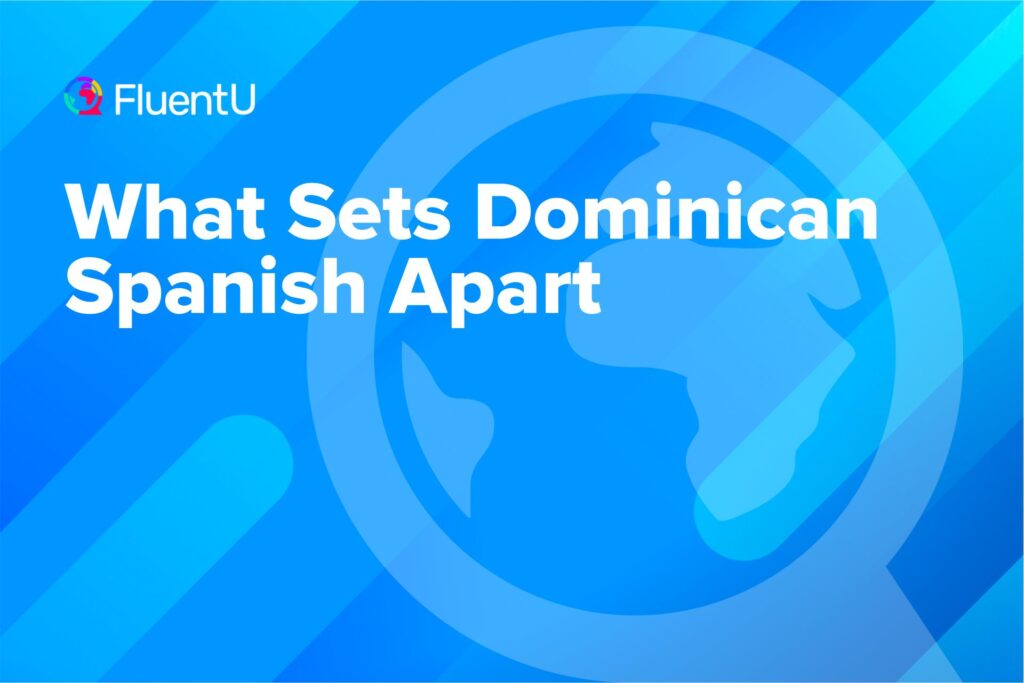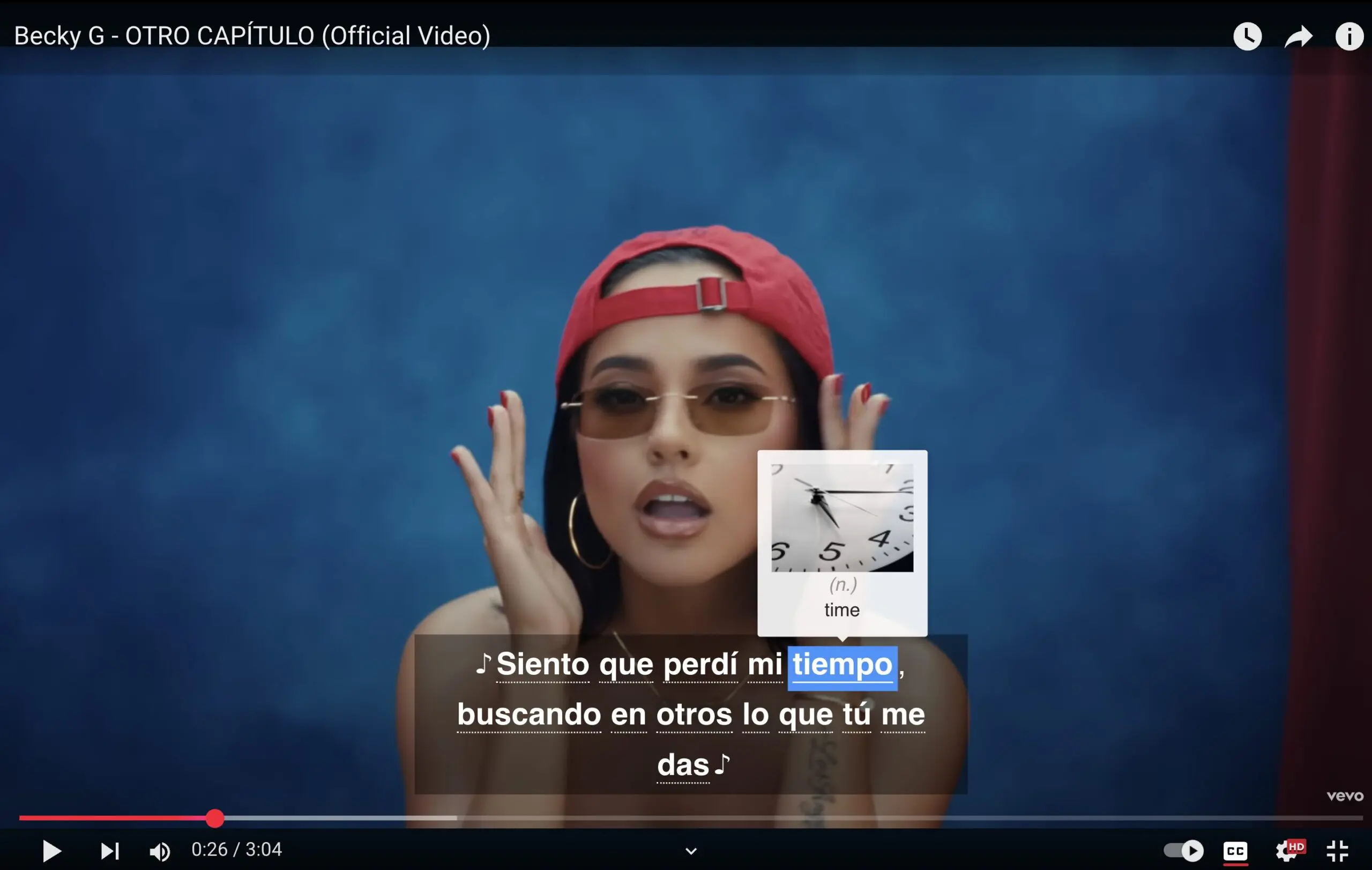Contents
- Personal Pronouns in Dominican Spanish
- Pronunciation Quirks in Dominican Spanish
- Regional Variations of Dominican Spanish
- Grammatical Differences in Dominican Spanish
- Indigenous Influences on Dominican Spanish
- Anglicisms in Dominican Spanish
- Dominican Slang Words and Phrases
- Films Featuring the Dominican Republic
- And One More Thing…
What Sets Dominican Spanish Apart

Dominicans have an energy and style that’s totally beyond compare. There are so many beautiful words that you need in your vocabulary, words like aguacero (heavy rain), callao (a pebble or a dance) and ratatá (really cool).
Learning how to speak and understand Dominican Spanish trains your ears and your tongue in a new dialect, and that means you can even try out new words and phrases that are unique to it.
Download: This blog post is available as a convenient and portable PDF that you can take anywhere. Click here to get a copy. (Download)
Personal Pronouns in Dominican Spanish
Unlike Spanish from Spain (also known as Peninsular Spanish), Dominican Spanish doesn’t use the pronoun vosotros as a second-person plural pronoun. Instead, it uses ustedes, like many other Latin American countries.
Vosotros and ustedes both refer to a group of people, so think of it as the American slang word “y’all” (or just a plural “you”).
If you’re not used to using ustedes, it’s super easy to learn. It follows the same conjugation rule as ellos and ellas.
For example:
Vosotros habláis → Ustedes hablan (You all talk)
Vosotros coméis → Ustedes comen (You all eat)
Vosotros vais → Ustedes van (You all go)
Pronunciation Quirks in Dominican Spanish
Included in this section are phonetic sounds (in square brackets.) For help pronouncing these sounds, refer to this IPA chart.
Dropping the s
Spanish in the Caribbean is faster and more relaxed than general Latin American Spanish. As with many Caribbean regions, Dominicans play it fast and loose with their s sound, omitting it nearly all of the time; I’d say they use this sound less than any other Spanish dialect.
This can be problematic for understanding and can create more homophones (words that sound the same but have different meanings) than usual. S is only pronounced as [s] (sounds like s) when there’s a stressed vowel in the next word. The rest of the time it’s silent or aspirated.
For example, in las alas (the wings), the underlined s would be pronounced because the a in bold is stressed, while the other s wouldn’t be pronounced. S within a word may also be deleted, e.g. isla is often pronounced as [ila] (sounds like “eyh-lah”)
Yeísmo
There’s no longer any difference between the y [ʝ-j] and ll [ʎ] sounds as both are pronounced like the first sound. This is known as yeísmo .
This is quite common in Spanish now, but it’s still worth being aware of. The best way of getting accustomed to these sounds is to listen to the IPA sounds by following the links placed below and notice the subtleties in pronunciation.
To help train your tongue to these sounds, notice that [ʎ] is produced with the tongue “sticking” to the roof of the mouth and [ʝ-j] requires a slightly looser tongue. Listening to and producing this sound repetitively should help you master it.
Yeísmo creates some homophones that you’ll want to watch out for, like baya (berry) and valla (fence.) Make sure you listen to the Latin American Spanish examples on the links and not the Spanish dialects!
Seseo
A pronunciation phenomenon known as seseo operates in Dominican Spanish as it does in all the Latin American Spanish varieties.
There’s no [θ] sound (“th” in English) in Dominican Spanish, only [s] (“s” in English). This means that s and z spellings are both pronounced as [s]. You’ll be familiar with this if you’re learning Latin American Spanish.
This again can create homophones, e.g. between la casa (the house) and la caza (the hunt.)
The Dominican N
N within a word is often nasalized to [ŋ] (sounds like the “ng” in the English “sing” or the Spanish Domingo (Sunday)) especially if followed by a vowel.
It may be left out altogether (and the previous vowel nasalized) if followed by b, d or g. For example, mango (mango) becomes [mãgo] (sounds like “mahn-go”) or possibly [maŋgo] (using the “ng” sound as above) depending on the speaker and the speed of speech.
The Dominican D
The d is silent in ado , ido and eda .
For example, casado (married) is [kasao] (sounds like “cas-a-oh,”), dedo (finger/toe) is [déo] (sounds like “day-oh”) and partido (game, competition) is [partío] (sounds like “part-i-oh”).
Regional Variations of Dominican Spanish
Cibao (North)
The birthplace of Merengue! This is definitely somewhere to visit the island. Famous for mountains and beautiful valleys, it’s an important fertile area for growing cacao and coffee.
Here, r and l at the ends of syllables can be pronounced as an i, e.g. correr (to run) can be [korei] (sounds like “cor-ay-ey.”)
Interestingly, this is thought to be an Afro-Portuguese feature that slaves who were born in Portugal picked up and brought to the area, later incorporating it into Dominican pronunciation as they learned Spanish.
L here is pronounced as [ʎ] (that “tongue stuck to the roof of your mouth” sound you practiced earlier) as in Portuguese, a subtle feature that you could easily miss if you’re not listening for it.
Ozama (South)
Known for its large lake, Enriquillo, the southern region is mostly arid and hot with stunning coastal lagoons.
The l at the end of syllables can be pronounced as r in this region. For example, Miguel may be [miɰer] (sounds like “mi-guer.”) This is a Puerto Rican feature that may have originated from Andalusia.
Seibo (East)
The great plains of the Caribbean are situated here, home to sugar plantations and savanna.
R and l sounds at the ends of words aren’t pronounced here, so fuerte can be [fuɛte] (sounds like “fu-e-tay.”)
Santo Domingo (Capital)
Santo Domingo is the first settlement of Europeans in the Americas and so has a great deal of history. The colonial zone of the city is a UNESCO heritage site! It also has winds that create a perfect temperate climate and a stunning metropolitan cityscape.
In Santo Domingo, the r at the end of a syllable is commonly pronounced as an l.
For example, correr (to run) can be [korel] (sounds like “cor-el”). This is also an Andalusian feature of speaking, although it’s less common in Puerto Rican speech.
Grammatical Differences in Dominican Spanish
As many Dominicans speak very rapidly, shortening of phrases is pretty common, e.g:
Speaker 1: [¿pondɛva?] (sounds like “pon-dev-ah”)
Speaker 2: [vuá santo ðomiŋgo] (sounds like “voo-ah san-toh do-miny-go”)
This might seem difficult to understand and, in a lot of cases, you may have to use context to help you work out what Dominicans mean, although many of them will slow down and enunciate for a gringo upon request.
You can also get your ears acquainted with the language on a program like FluentU, which uses Spanish videos with interactive subtitles to teach you the language.
FluentU takes authentic videos—like music videos, movie trailers, news and inspiring talks—and turns them into personalized language learning lessons.
You can try FluentU for free for 2 weeks. Check out the website or download the iOS app or Android app.
P.S. Click here to take advantage of our current sale! (Expires at the end of this month.)

Use the phrase-shortening guide below to help you work out what the speakers are saying:
[pondɛva] for ¿para dónde vas? (where are you going?)
[vuá] for Voy a (I’m going to)
Also unique to the Caribbean is the phrase: ¿Cómo tú estás? instead of ¿Cómo estás tú? Use this phrase to sound more natural and native with Dominicans.
Another thing you might want to listen out for and practice is the elongation of the last syllable of a sentence or phrase, especially for exaggeration. This is a very Dominican thing that you’ll definitely want to emulate.
Indigenous Influences on Dominican Spanish
The indigenous language of Hispaniola was Taíno at the time of the Spanish arrival. This was hugely important for the Spanish language as many words for things they encountered there were borrowed from Taíno.
Basically, almost everything found in the Caribbean and not in Europe is given a Taíno name. Sometimes the meaning was changed slightly, as there was already a word in Spanish for the overarching category, but a more specific word was needed by the Spanish settlers. That’s how hurakã (storm) in Taíno became huracán (hurricane) in Spanish.
So, what does this mean for your language learning?
Apart from being interesting, being aware of Taíno words used in the Dominican Republic helps you to understand what’s being said and respond in a more natural way than if you use standard Spanish terminology, which may be understood but may also mark you out as a non-native.
It’s also interesting to note that many of the words we use in English, like manatee, hurricane and barbecue all come from Taíno words! Here are some Dominican Taíno words for you to learn:
- Nana (little girl)
- Batata (sweet potato)
- Maco (toad)
- Jicotea (turtle)
- Cacata (tarantula)
- Chinchín (a bit)
Anglicisms in Dominican Spanish
As with many Caribbean dialects, anglicisms, especially brand name anglicisms, are common. Some are definitely more obvious than others.
You’ll want to know that anglicisms don’t always mean what you think they do based on their sound. For example, polo shé means a merchandise jersey (football/baseball/rugby) rather than a regular polo shirt.
And zafacón means any rubbish bin, not the “safety can” it’s an anglicism of. Anglicisms occur mostly in slang rather than regular language and the Spanish equivalents will always be understood.
Now, it’s time to move on to our Dominican films!
These will help you hear, learn and practice all of the above lessons.
Dominican Slang Words and Phrases
If you don’t know Dominican slang yet, you’ll definitely need to add these to your vocabulary list before taking your trip or talking to your Dominican friends.
Here are 16 of the most common Dominican slang words and phrases, but for our full list, click here.
- Acotejar — to get used to your surroundings
- Alebrescado / Alebrestado — to be excited and anticipating something
- Bacano — Cool
- Chercha — A party/good time
- Chin — A little bit
- Jevi — Nice
- Yala — Okay/alright
- Pana — Buddy/pal/bro
- Dame dato… — Tell me about it…
- Mai / Pai — Mom/dad
- ¿Qué lo what? — What’s going on? / what’s up?
- Jeva / Jevo — Girlfriend/boyfriend
- Chulo — Cute/cool
- Tiguere — Someone with street smarts
- Nítido — Great/cool
- Vaina — Thing
Films Featuring the Dominican Republic
Some of the best documentaries on the Dominican Republic start off our list.
“Ballplayer: Pelotero”
The real baseball story and the difficulties that face recruits from the Dominican Republic are all portrayed in this film.
There isn’t as much Dominican Spanish in this one as some other films, but it’s a very interesting cultural facet to explore, with relevant takeaways for any sports fan.
“Sugar”
Another great film, following much of the same theme as the one above, it features some Dominican dialogue but its not extensive. A very gripping and emotional story, well worth watching.
“The Price of Sugar”
A heartbreaking documentary on the price paid by sugar workers throughout Hispaniola’s society. The dialogue isn’t as clear as in the more polished feature films here, because the filming of this documentary is more authentic. You might want to watch this one last. It has a clear message of commercial impact and is truly compelling to watch.
“Colors of the Dominican Carnival”
If witnessing a Caribbean carnival is on your wish list, you absolutely must watch this documentary. The narration is in English but there are many interviews with Dominicans to help your language skills. The cultural element is phenomenal and will help you capture the spirit of the Dominican at home with this spectacular filming.
Two great movies to train your Dominican ear are still coming at you.
“Trópico de sangre” (Tropic of Blood)
A beautiful film illuminating the light and the dark of Trujillo’s regime in the Dominican Republic. The leading lady, Michelle Rodriguez, is Dominican by birth and much of the language is useful for learning Dominican. This true story is poignant of Dominican’s painful past.
“La hija natural” (The Love Child)
A story of a teenager in search of her father, when she finds him she must come to terms with what she finds and the nature of her existence. Set in the Dominican countryside with many cultural anecdotes and great dialogue, it gives a good insight to Dominican life.
Time to practice, grab an esquimalito (popsicle) and get watching some Dominican culture!
Download: This blog post is available as a convenient and portable PDF that you can take anywhere. Click here to get a copy. (Download)
And One More Thing…
If you want to learn Spanish with authentic materials but need a little extra support, then you need to know about FluentU.
FluentU lets you consume the same content as native Spanish speakers, but with tools to make it easier to pick up the language while you watch. You’ll learn Spanish as it’s actually spoken by real people, unlike programs that use scripted content.
You can bring our learning tools directly to YouTube or Netflix with the FluentU Chrome Extension, or check out our curated video library full of clips that cover a wide range of topics, as you can see here:
FluentU brings native videos within reach with interactive subtitles. You can tap on any word to instantly see its meaning, an image, and its audio pronunciation. Click on the word for additional examples and to add it to your flaschards.
To reinforce what you've learned, you'll complete engaging exercises and see more examples of the key words from the video. FluentU keeps track of the vocab you’re learning, and gives you extra practice with difficult words.
Start using the FluentU website on your computer or tablet or, better yet, download the FluentU app from the iTunes or Google Play store. Click here to take advantage of our current sale! (Expires at the end of this month.)











